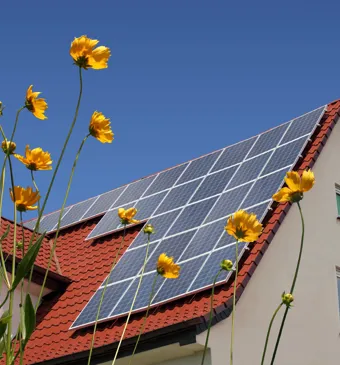Solar panels: mortgage & tax
With current energy prices, installing solar panels on your home has become even more attractive. But can you finance solar panels through your mortgage, and how does VAT work? This page explains everything you need to know.

Solar panels are a smart investment for your home. They generate your own electricity, saving you hundreds of euros each year. Your monthly energy costs decrease, and you can reclaim the VAT paid on the installation of the solar panels from the tax office. As a result, you often recover the full investment within about seven years. If you do not have enough savings to buy solar panels, you may be able to increase your existing mortgage.
Increasing your mortgage for solar panels
Would you like to finance solar panels through your mortgage? In many cases, this is possible. If you inform your mortgage provider that you want to increase your mortgage for solar panels, they often approve it. After all, your monthly expenses immediately decrease due to lower energy costs — freeing up money to cover the slightly higher mortgage payments.
However, there are limits. Your total mortgage cannot exceed 106% of your home's value, and an income assessment is also required. To understand what this means for your situation, always consult your mortgage advisor.
What counts as energy-saving measures for your mortgage?
Solar panels are considered energy-saving measures for your mortgage. If you are buying a home and plan to make it more sustainable — for example, by financing solar panels through your mortgage — you can borrow more than usual. In 2024, you can borrow up to 106% of your home’s value (instead of the standard 100%) when funding energy-efficient upgrades.
Do solar panels increase your home's value?
Do solar panels raise your home's value? In most cases, yes. While it depends on factors like the number of panels and their quality, installing solar panels usually boosts your property's appeal to future buyers.
Solar panels can improve your home’s energy label and significantly lower monthly energy bills. Plus, buyers may qualify for a larger mortgage when purchasing an energy-efficient home.
Costs and savings of solar panels
The cost of installing solar panels depends on factors such as the type of panel and its capacity. Below is an overview of the average costs and savings (source: Milieu Centraal).
| Number of solar panels | Costs (ex. VAT) | Annual savings | Approximate payback period |
| 6 | € 3,100 | € 320 | 8 jaar |
| 10 | € 4,500 | € 500 | 7 jaar |
| 18 | € 7,000 | € 800 | 8 jaar |
VAT Exemption for Solar Panels
As of 1 January 2023, private individuals no longer pay VAT on solar panels installed on their homes. The 0% rate applies to both the supply and installation of solar panels on or near a residence — including garages, sheds, extensions, conservatories, and even holiday homes.
The 0% rate also covers additional costs like cable installation, mounting materials, optimisers, inverters, and any necessary adjustments to your meter cupboard due to the installation.
However, other work, such as reinforcing your roof, is still subject to the 21% VAT rate.
Claiming VAT on solar panels
Since the VAT rate is now 0%, there is no need to reclaim VAT from the tax office. However, the tax office still considers you a VAT entrepreneur, as you supply energy back to your energy provider.
For most private individuals, if your annual revenue is below €1,800 and your solar panels' capacity is under 10,000 Watt peak, you do not need to register as a VAT entrepreneur.

Example: Solar panels installed in 2022, invoice dated 2023
You received a quote on 1 November 2022 for the installation and delivery of solar panels. No down payment was required. The solar panels were delivered and installed on 15 December 2022. The date on the invoice you received later is 15 January 2023. The VAT rate on this invoice is 0%, as the invoice date falls in 2023.
Example: Multiple invoices in 2022 and 2023
You ordered solar panels in November 2022. The panels were delivered on 28 December 2022. The supplier requested a down payment by 15 December. You received two invoices.The first invoice, for the down payment, is dated 1 December 2022. This invoice shows a VAT rate of 21%. The second invoice, for the remaining amount, is dated 15 January 2023. This invoice shows a VAT rate of 0%.
If you received an invoice in 2022 with a VAT rate of 21%, you can claim back the VAT on the purchase and installation of solar panels from the Tax Authorities.
The Tax Authorities consider you an entrepreneur when you wish to reclaim VAT. The person whose name is on the energy bill can apply for the VAT refund. To do this, you need the invoice for the purchase, installation, and maintenance of the panels. You must also know the total power output capacity.
To reclaim VAT, follow these three steps:
- Download the form 'Registration form for solar panel holders' from the Tax Authorities' website and use it to register yourself as a VAT entrepreneur.
- Once this is approved, you will receive your VAT number and VAT return form.
- After you have reclaimed the VAT, you can request an exemption from VAT returns from the Tax Authorities.
Other ways to make your home more sustainable
In addition to installing solar panels on your home, there are many other ways to make your property more energy-efficient. These include insulating your roof, floors, or walls, or installing a heat pump.